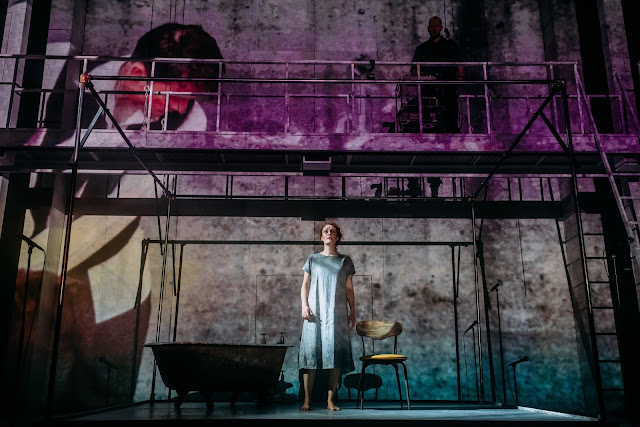Discussing design with Duchess [of Malfi] director Zinnie Harris
Part of our Citizens Women season, The Duchess [of Malfi] follows the recently widowed Duchess as she gains financial independence, prioritises her passions and refuses the authority of her brothers with horrifyng consequences.
Here, writer and director Zinnie Harris discuses how the design choices and staging help tell the Duchess' story. (This conversation includes plot spoilers!)
How important is the relationship between the director and the designer, from your point of view?
What was the reason for using video in the Duchess’ torture scene?
This isn't design related, but can you say something about the movement piece the women do after the Duchess’ death?
For more behind the scenes insights, have a read of our Q&A with Lighting Designer Ben Ormerod, where he explains how lighting choices help to emphasise key moments in the story.
The Duchess [of Malfi] is a co-production with The Royal Lyceum Theatre Edinburgh.
This powerful story of family, forbidden love and fierce gender politics runs at Tramway until 21st September. Tickets can be booked online or by calling our Box Office team on 0141 429 0022.
Here, writer and director Zinnie Harris discuses how the design choices and staging help tell the Duchess' story. (This conversation includes plot spoilers!)
 |
| Kirsty Stuart as The Duchess Image by Mihaela Bodlovic |
How important is the relationship between the director and the designer, from your point of view?
People think a designer goes away and designs and that’s not
what happens. Tom Piper and I would spend a long time sitting with the model
box. He would send me sets of references and I would say ‘oh I like the
industrialness of that or the calm of that’. After the first draft of the
designs I made some radical suggestions and the second design draft was quite
different. There’s always a limit to what you can do with a space but I
had wanted it quite open…the walkway, I wanted the sense that people could look
up and down, and to be able to transform the space from a public place into an
intimate space and then into a basement in the second half. I wanted the
walkway so that conversations could be overheard and overlooked, but also so that in
the second act Ferdinand could see down into the basement, into the box (where the Duchess is imprisoned).
Do the stairs up to the walkway change between Act One
and Act Two, or did I imagine that?
Yes, they are steps in the first act, and it’s a public
place with windows but it’s a ladder in the second act…it’s become a covert
basement space, so we wanted the sense of going into a cellar.
 |
| Fletcher Mathers and Kirsty Stuart in The Duchess [of Malfi] Image by Mihaela Bodlovic |
What was the reason for using video in the Duchess’ torture scene?
In the original play there is a moment where she is shown a
waxwork model and made to think it’s the dead body of her husband, so I thought
what’s the modern equivalent of that? It’s fake news, so we had the video
played again and again, like brainwashing her.
 |
| Adam Best and Graham Mackay-Bruce in The Duchess [of Malfi] Image by Tim Morozzo |
The characters have their names projected on the back
wall as they enter – what’s the reason for this?
I wanted the sense of them being like a set of playing cards
and it adds to the ensemble nature of the piece. It’s called The Duchess
but it’s as much about the men and the way they behave.
What other really important functions did you want the
design to serve?
I wanted the audience to understand as soon as the show
started that this is not a period Jacobean play, that it’s contemporary and
modern. So an electric guitar hits out at you immediately and you’re led
down a certain route with harsh lines and stark lighting to understand that
world.
 |
| Fletcher Mathers, Eleanor Kane and Kirsty Stuart in The Duchess [of Malfi] Image by Mihaela Bodlovic |
This isn't design related, but can you say something about the movement piece the women do after the Duchess’ death?
There is the torture and then the execution but I absolutely
wanted this not to be the women’s last word but for them to take their
revenge. The musician is the ghost from the future who is there at
various moments and she sings them back to life. It is not a rhythmic
piece and starts slowly but becomes almost like a song women might have sung as
they worked in the fields or did washing – it’s about strength and defiance.
For more behind the scenes insights, have a read of our Q&A with Lighting Designer Ben Ormerod, where he explains how lighting choices help to emphasise key moments in the story.
The Duchess [of Malfi] is a co-production with The Royal Lyceum Theatre Edinburgh.
This powerful story of family, forbidden love and fierce gender politics runs at Tramway until 21st September. Tickets can be booked online or by calling our Box Office team on 0141 429 0022.


Comments